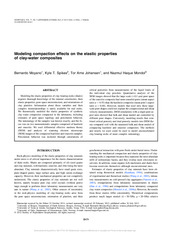Modeling compaction effects on the elastic properties of clay-water composites
Peer reviewed, Journal article
Published version
Permanent lenke
https://hdl.handle.net/1956/8694Utgivelsesdato
2012-09Metadata
Vis full innførselSamlinger
- Department of Earth Science [1050]
Originalversjon
https://doi.org/10.1190/geo2011-0426.1Sammendrag
Modeling the elastic properties of clay-bearing rocks (shales) requires thorough knowledge of the mineral constituents, their elastic properties, pore space microstructure, and orientations of clay platelets. Information about these variables and their complex interrelationships is rarely available for real rocks. We theoretically modeled the elastic properties of synthetic clay-water composites compacted in the laboratory, including estimates of pore space topology and percolation behavior. The mineralogy of the samples was known exactly, and the focus was on two monomineralic samples comprised of kaolinite and smectite. We used differential effective medium theory (DEM) and analysis of scanning electron microscope (SEM) images of the compacted kaolinite and smectite samples. Percolation behavior was included through calculations of critical porosities from measurements of the liquid limits of the individual clay powders. Quantitative analysis of the SEM images showed that the large scale (>0.1 μm) pore space of the smectite composite had more rounded pores (mean aspect ratio α = 0.55) than the kaolinite composite (mean pore’s aspect ratio α = 0.44). However, models that used only these largescale pore shapes could not explain the compressional and shear velocity measurements. DEM simulations with a single pore aspect ratio showed that bulk and shear moduli are controlled by different pore shapes. Conversely, modeling results that combined critical porosity and dual porosity models into DEM theory compared well with the measured bulk and shear moduli of compacting kaolinite and smectite composites. The methods and results we used could be used to model unconsolidated clay-bearing rocks of more complex mineralogy.
